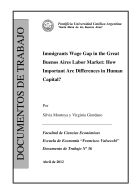Por favor, use este identificador para citar o enlazar este ítem:
https://repositorio.uca.edu.ar/handle/123456789/2281| Título: | Immigrants wage gap in the Great Buenos Aires labor market : how important are differences in human capital? | Autor: | Montoya, Silvia Giordano, Virginia |
Palabras clave: | INMIGRANTES; CAPITAL HUMANO; MERCADO LABORAL; SALARIO | Fecha de publicación: | 2012 | Editorial: | Universidad Católica Argentina. Facultad de Ciencias Económicas | Cita: | Montoya, S., Giordano, V. (2012, abril). Immigrants wage gap in the Great Buenos Aires labor market : how important are differences in human capital? [en línea]. Documento de trabajo No. 36. Escuela de Economía “Francisco Valsecchi”. Facultad de Economía de la Universidad Católica Argentina. Disponible en: https://repositorio.uca.edu.ar/handle/123456789/2281 | Resumen: | Abstract: Labor market performance of native and immigrant workers differ in terms of their employment opportunities, their insertion by sector of employment, their labor legislation protection and their income. This paper analyses why the two groups of workers perform so differently by estimating a Mincer equation and decomposing income differentials using the Oaxaca-Blinder method. The difference in income is assigned to different effects, endowment and return to those endowments. Immigrants have a higher probability of working in low productivity jobs and of being exposed to higher than average informality. Moreover, both internal and border country immigrants face a lower rate of labor legislation protection, have on average a lower level of human capital and earn lower income than native workers. Consistently, immigrants earn less than natives, being immigrants from border countries in worse situation than internal immigrants as opossed to that reference group. Female immigrants earn systematically less than their natives counterparts. Wage gap ranges from 13% to 71 % percent. Part of the wage gap is attributable to occupational segregation i.e. immigrants crowding into lower paid highly-informal occupations. The analysis shows that Native workers have on average more favorable characteristics, and experience slightly higher returns to these characteristics in terms of income than immigrant workers even after controlling for occupational insertion. | Cobertura Espacial: | BUENOS AIRES. PROVINCIA ARGENTINA |
URI: | https://repositorio.uca.edu.ar/handle/123456789/2281 | Disciplina: | ECONOMIA | Derechos: | Acceso Abierto |
| Appears in Collections: | DTE 2012 |
Files in This Item:
| File | Description | Size | Format | |
|---|---|---|---|---|
| immigrants-wage-gap-great.pdf | 680,91 kB | Adobe PDF |  View/Open |
Page view(s)
396
checked on Dec 12, 2025
Download(s)
270
checked on Dec 12, 2025
Google ScholarTM
Check
This item is licensed under a Creative Commons License

